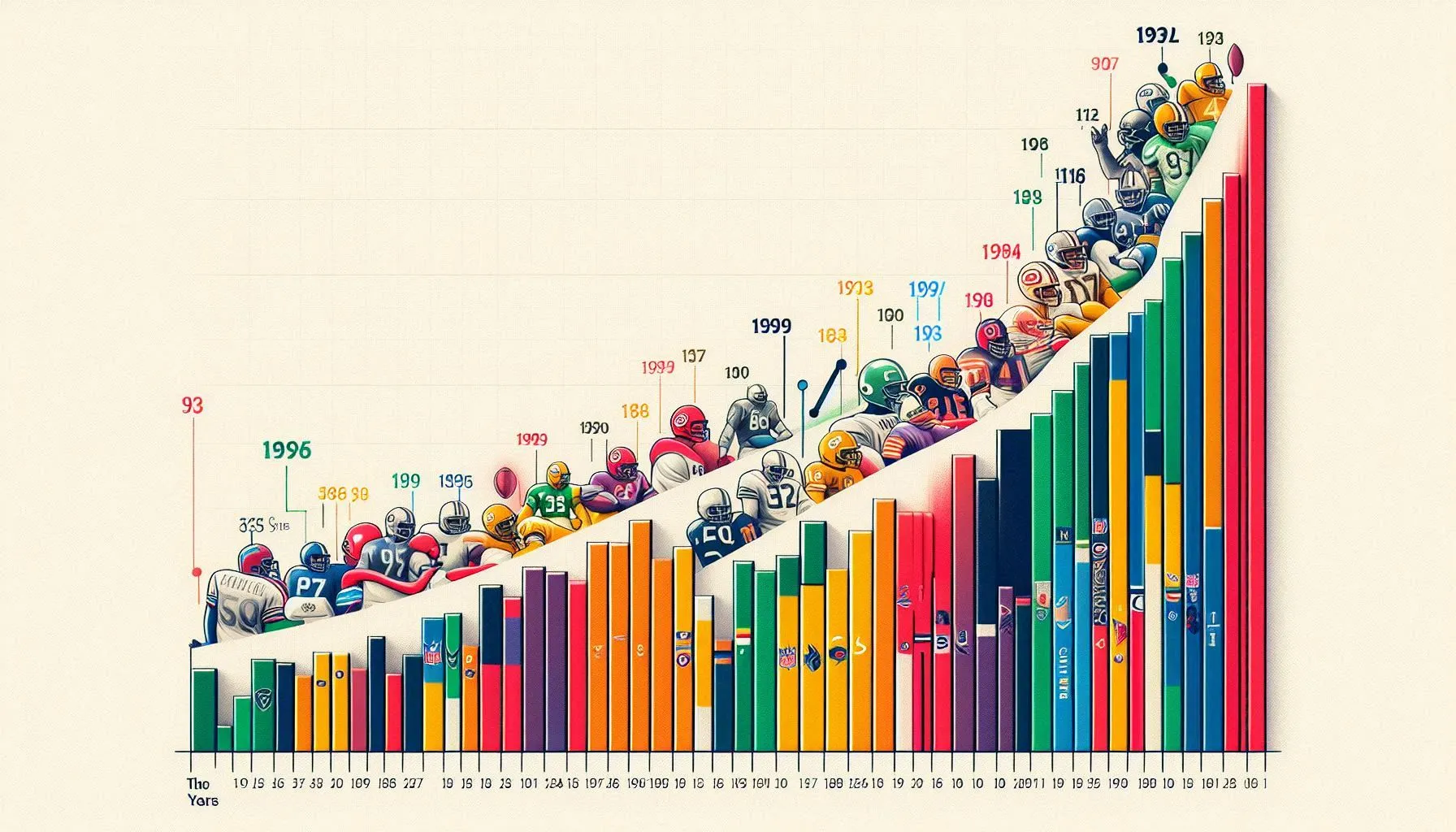
Introduction to NFL Scores
NFL scores serve as a fundamental component in the realm of American football, representing the culmination of a team’s efforts on the field. These scores encapsulate the success of various plays, reflecting individual moments that contribute to the overall outcome of a game. In essence, scoring is not just a numerical representation but a critical narrative that unfolds throughout the matchup.
The scoring system in the NFL is defined by several key components, including touchdowns, field goals, extra points, and safeties. A touchdown, which awards a team six points, occurs when a player successfully carries or catches the ball in the opponent’s end zone. Following a touchdown, teams have the opportunity to score an additional point through a kick, known as the extra point, or opt for a two-point conversion by advancing the ball into the end zone once more. Field goals, worth three points each, can be attempted from various distances, typically serving as a strategic alternative when a touchdown is out of reach. Lastly, a safety, awarded two points, occurs when the defending team successfully tackles an opponent in their own end zone.
The significance of NFL scores extends beyond mere numbers on a scoreboard; they embody the passion of fans and the competitive spirit of teams. For supporters, each score serves as a moment of celebration or despair, igniting emotions that contribute to the overall experience of the game day atmosphere. Scores can shape narratives, influence strategies, and even determine playoff outcomes, reinforcing their crucial role in football culture. As such, scores are not merely an aspect of American football; they are integral to the sport’s identity and its enduring appeal to fans around the world.
Historical Overview of NFL Scoring
The origins of scoring in the National Football League (NFL) can be traced back to its inception in 1920. Initially, the rules governing the scoring system were fairly rudimentary; touchdowns were worth six points, and extra points or conversions were awarded in limited scenarios. Over the decades, the NFL has witnessed numerous rule modifications that have significantly influenced the manner in which points are accumulated during games.
One of the most notable changes occurred in 1974, when the NFL introduced the two-point conversion option, allowing teams to pursue an additional two points following a touchdown, a move that notably added strategic depth to scoring scenarios. Another landmark moment came with the NFL’s decision in 2011 to provide protection for quarterbacks, thereby increasing the likelihood of passing touchdowns as offenses began to thrive around established quarterbacks rather than the run game.
Significant games and moments throughout NFL history have also played a crucial role in shaping perceptions of scoring. For instance, the “Greatest Show on Turf” in the late 1990s and early 2000s showcased high-scoring offenses, paving the way for new offensive strategies that prioritized passing and quick scoring. These thrilling performances not only raised the bar for future teams but also managed to elevate fan expectations regarding scoring potential. As a consequence, the excitement surrounding scoring increased, placing pressure on teams to deliver more points in an increasingly competitive environment.
As we move towards the present day, it becomes evident that scoring in NFL games has evolved from a simplistic system to a complex and strategic element that defines the very essence of the sport. With the emergence of advanced analytics and increased offensive creativity, one can only speculate how these factors might shape the future landscape of NFL scoring.
Current Trends in NFL Scoring
The National Football League (NFL) has seen significant developments in scoring trends over recent seasons, reflecting a shift in offensive strategies and game dynamics. As of the 2023 season, teams are averaging approximately 25 points per game, signifying an upward trend in overall scoring. This increase can be attributed to several factors, including the rise of high-scoring offenses, the implementation of advanced analytics, and changes in game formats.
High-scoring offenses have become more prevalent, with teams increasingly adopting aggressive approaches to play-calling. Quarterbacks are not only expected to excel in their decision-making but also to push the ball downfield, resulting in an increase in passing yards and touchdowns. This offensive explosion is further aided by the proliferation of skilled wide receivers and tight ends, who are capable of making significant plays. Notable examples such as Patrick Mahomes and Josh Allen have demonstrated how potent offenses can dramatically influence scoring levels in the NFL.
Analytics also plays a crucial role in modern NFL strategy. Coaching staffs now frequently utilize data-driven insights to enhance their offensive tactics, leading to more calculated risks and aggressive play selections. For instance, teams are more likely to go for it on fourth down, indicating a transformative approach towards scoring opportunities. This analytical trend is reshaping how teams manage game situations, factoring in points efficiency and potential yardage gain.
Moreover, the format of NFL games continues to influence scoring dynamics. The two-minute warning and overtime rules incentivize teams to engage in more high-pressure scoring situations, often resulting in dramatic, last-minute drives. These modifications and the broader scoring landscape underline the continuously evolving nature of the NFL, which adapts to player skills, analytical advancements, and fan expectations. As the league continues to evolve, it will be fascinating to observe how these trends shape future scoring and the overall game experience.
The Role of Technology in Scoring
The incorporation of technology in the National Football League (NFL) has revolutionized the way scores are recorded, viewed, and analyzed. One of the most significant advancements is the implementation of live scoring updates. Fans, officials, and analysts now have the ability to receive real-time scoring data through various platforms, including mobile applications and websites. These live updates provide instant access to the current score, play-by-play actions, and individual player statistics, enabling a more engaging viewing experience.
Furthermore, stat tracking technologies have become essential tools in assessing player and team performance. The NFL employs sophisticated tracking systems that monitor every movement of players during games. This data captures intricate details such as speed, distance covered, and player positioning. Such metrics allow coaches and analysts to evaluate scoring efficiency and overall game strategy in ways that were previously unattainable. The advent of these analytics has made it possible to dissect strategies, assess scoring opportunities, and optimize team performance on the field.
Social media has also played a pivotal role in the dissemination of scoring information. Platforms like Twitter and Instagram provide fans with instantaneous updates on game scores, highlights, and critical statistics. This rapid flow of information fosters a heightened sense of community by enabling fans to engage in discussions and share opinions about the game as it unfolds. It has essentially created a digital landscape where scoring updates and team news are not only delivered promptly but are also widely shared among the audience.
As technology continues to evolve, its impact on how scores are understood and appreciated in the NFL will only grow. Advanced metrics and software will increasingly shape how teams develop their strategies and how fans consume the sport, reinforcing the significance of technology in the realm of scoring.
Fan Engagement and NFL Scores
The scoring system in the National Football League (NFL) plays a pivotal role in not only the game itself, but also in shaping fan engagement and experience. Generally, the fan’s emotional connection to a team often intensifies with each score; the excitement of touchdowns, field goals, and defensive stands creates a dynamic narrative that fans invest in emotionally. As the game progresses, these moments of scoring become focal points around which fans rally, influencing attendance, viewership, and overall engagement.
Fantasy football leagues further illustrate how scoring drives fan interaction. Participants actively track players’ performance and fantasy points, transforming how they consume games. Fans become invested not only in their favorite teams but also the individual players—this dual focus amplifies their engagement. Each score impacts their fantasy standings, making the stakes higher and the game more thrilling. Similarly, the rise of sports betting has revolutionized how fans interact with NFL scores. With legal sports betting becoming more accessible, fans are not merely spectators; they are positioned as active participants, where every point scored can significantly impact their bets, further fueling excitement and engagement.
Broadcasts, too, have evolved to highlight scoring trends and their implications, illustrating how pivotal scores can be in shaping a game’s trajectory. Networks now provide real-time statistics and scoring updates that deepen fans’ understanding of the context behind each score. Additionally, special segments dedicated to analyzing scoring plays, such as touchdown celebrations and impactful penalties, further draw fans into the action, creating a richer viewing experience.
Overall, the excitement generated by scoring not only enhances the live experience in stadiums but also plays a significant role in boosting television ratings, as fans eagerly tune in to witness pivotal moments that may define the outcome of games, enhancing collective excitement around the NFL.
Impact of Scoring on Team Strategy
In the National Football League (NFL), the scoring system is not merely a set of numbers displayed on the scoreboard; it profoundly influences team strategies and overall game planning. The dynamics of scoring shape the way teams’ approach both offense and defense, impacting decisions made during crucial moments of a game.
Offensively, the importance of scoring is evident through the varying strategies teams adopt to convert opportunities into points. Teams frequently analyze their scoring efficiency when devising plays, balancing short-term gains with long-term objectives. For instance, when a team finds itself trailing in the score, it is often forced to take riskier plays or abandon their initial game plan to maximize scoring chances. Conversely, a leading team may opt for conservative tactics, focusing on ball control and time management to maintain their advantage.
The strategic consideration of two-point conversions exemplifies profound tactical decisions in relation to scoring. Teams must weigh the potential benefits against their current score, timing, and the effectiveness of their offense. This choice is especially critical in high-stakes situations, where a successful two-point conversion could provide a crucial edge to secure victory. Coaches and players must remain adaptable and responsive to the evolving scoring trends, constantly reassessing their strategies to optimize potential scoring chances.
Moreover, the changing landscape of scoring trends—driven by rule changes and evolving playing styles—also compels coaches to modify their strategies. The introduction of innovations in scoring plays, such as the implementation of the extra point and the challenge of field goals, has encouraged teams to rethink their offensive and defensive game plans. As such, maintaining an acute awareness of scoring trends can enhance a team’s chances of success on the field.
Overall, scoring serves as a foundational element in the strategic framework of NFL teams, influencing decisions on how they approach each game. Analyzing these scoring impacts reveals the intricate connections between game management and scoring efficiency.
Challenges and Controversies in NFL Scoring
The NFL has evolved significantly over the years, but along with that evolution comes a plethora of challenges and controversies, particularly regarding the scoring system. This aspect of the game has increasingly drawn scrutiny due to inconsistent officiating, scoring reviews, and contentious play reviews that can dramatically influence game outcomes.
One of the primary challenges is the inconsistency in officiating, which can lead to disparate interpretations of the rules during critical moments of a game. Officiating decisions concerning targeting or pass interference often result in heated debates among players, coaches, and fans alike. Fans have expressed dissatisfaction when the application of the rules seems subjective or inconsistent, leading to perceptions of unfairness in the league. In many instances, the same type of play may be called differently in various games or moments, escalating frustration among supporters of the teams involved.
Another significant source of contention arises from the process of scoring reviews. The NFL introduced a review system to ensure accuracy in officiating decisions, yet the speed at which these reviews are conducted has been the root of much criticism. In some cases, the delays caused by lengthy reviews disrupt the natural flow of the game, eliciting frustration from both fans and players. Additionally, controversies surrounding specific calls, such as whether a touchdown was valid or if a player’s catch was indeed complete, can overshadow the excitement of the game.
These challenges not only influence game outcomes but also impact fan loyalty and perception of the league’s integrity. Understanding these controversies is essential to grasping the complexities of NFL scoring and its implications on the overall sporting experience.

Future Prospects for NFL Scoring
The future of NFL scoring is poised for significant evolution as various factors converge to shape the game’s dynamics. Current trends indicate a burgeoning emphasis on offensive strategies, often characterized by high-scoring games. As teams continue to refine their offensive playbooks, the evolution of scoring could see higher point totals becoming more commonplace. This trend may prompt the league to consider adjustments in rules to facilitate scoring further, potentially leading to alterations in how penalties are enforced or changes in the game clock management.
One of the pivotal areas that may impact the future of NFL scoring is the implementation of advanced analytics. As teams increasingly leverage data-driven approaches, the capacity to analyze offensive and defensive plays might lead to innovative strategies that could change how coaches design their game plans. Furthermore, the potential emergence of new formations and play styles could create mismatches that translate into higher scores, thereby enhancing the entertainment value of the games.
Additionally, technological advancements hold the promise of transforming how scoring is recorded and analyzed. Wearable technology and improved broadcast analytics may provide deeper insights into player performance, thus enabling teams to strategize more efficiently. With such tools, coaching staff can identify trends in real-time, adjusting their tactics during the game to maximize scoring opportunities.
Moreover, if player safety continues to be prioritized, the league might opt for rule changes that could inadvertently lead to scoring spikes. For instance, enhanced protections for quarterbacks might result in increased passing attempts and subsequently more scoring chances. Overall, the synthesis of innovative coaching, advanced analytics, and technology promises an exciting trajectory for NFL scoring in the years to come.
Conclusion: The Scoreboard of Tomorrow
Throughout this exploration of NFL sport scores, we have witnessed a transformative journey that spans both history and current trends, illuminating the critical role that scores play in shaping the overall football experience. Initially, the way scores were recorded and communicated has evolved significantly. From rudimentary tally methods to today’s sophisticated digital systems, the presentation of scores has changed alongside advancements in technology. These innovations not only enhance the visual appeal but also provide real-time data that enriches fan engagement.
In the present landscape, NFL scores serve as more than mere numbers; they encapsulate a myriad of statistics and analytics that deepen our understanding of each game. As fans, our interaction with these scores is instant and immersive, thanks to extensive media coverage and mobile technologies. This integration allows for an experience that is both immediate and forethoughtful, vastly improving how spectators consume NFL-related content. Consequently, this has fostered a culture where the score is not just a reflection of a game’s outcome, but also a foundation upon which fans build their narratives and analyses.
Looking forward, the future of NFL scoring promises even greater advancements. The potential incorporation of artificial intelligence and enhanced data analytics is likely to redefine how scores are recorded and presented. Moreover, as we embrace augmented reality (AR) and virtual reality (VR) technologies, the experience surrounding NFL scores could evolve into an interactive spectacle, fostering deeper connections between fans and the teams they support. Understanding the trajectory of NFL scores is essential in appreciating the game’s ongoing evolution. This anticipation underscores the significance of scores as not only historical data points but as an essential element of the vibrant NFL culture.


